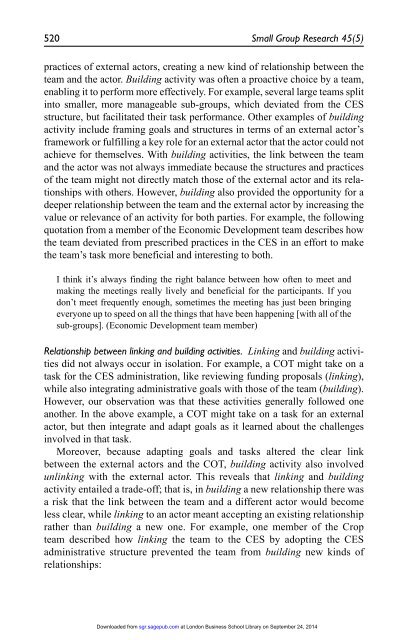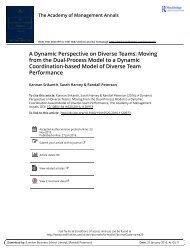The Process of Team Boundary Spanning in Multi-Organizational Contexts - Sarah Harvey, Randall S. Peterson, and N. Anand
Work teams must increasingly operate in complex environments characterized by multiple external actors beyond team and organizational boundaries. Although previous research demonstrates the importance of boundary spanning activities to team effectiveness, it reveals relatively little about the process of boundary spanning in these environments. In this article, we investigated the processes of boundary spanning across multiple external actors in 10 cross-organizational teams. We identified three sequences for reaching out to external actors: (a) moving inside-out from vertical actors inside the host organization to horizontal actors outside of the host organization, (b) moving outside-in from horizontal actors to vertical, and (c) staying-inside with vertical actors from the host organization. Our observations suggest that inside-out and outside-in sequences were more successful than simply pleasing the host organization. We build on our empirical findings to develop a process theory of how team boundary spanning activities across multiple external actors influence team effectiveness. Our research underscores the importance of a team’s interactions with actors in its external environment beyond those in an immediate supervisory role and provides insight into the dynamics of boundary spanning in multi-organizational contexts.
Work teams must increasingly operate in complex environments
characterized by multiple external actors beyond team and organizational
boundaries. Although previous research demonstrates the importance of
boundary spanning activities to team effectiveness, it reveals relatively little
about the process of boundary spanning in these environments. In this article,
we investigated the processes of boundary spanning across multiple external
actors in 10 cross-organizational teams. We identified three sequences for
reaching out to external actors: (a) moving inside-out from vertical actors inside
the host organization to horizontal actors outside of the host organization,
(b) moving outside-in from horizontal actors to vertical, and (c) staying-inside
with vertical actors from the host organization. Our observations suggest
that inside-out and outside-in sequences were more successful than simply
pleasing the host organization. We build on our empirical findings to develop
a process theory of how team boundary spanning activities across multiple
external actors influence team effectiveness. Our research underscores the
importance of a team’s interactions with actors in its external environment beyond those in an immediate supervisory role and provides insight into the
dynamics of boundary spanning in multi-organizational contexts.
Create successful ePaper yourself
Turn your PDF publications into a flip-book with our unique Google optimized e-Paper software.
520 Small Group Research 45(5)<br />
practices <strong>of</strong> external actors, creat<strong>in</strong>g a new k<strong>in</strong>d <strong>of</strong> relationship between the<br />
team <strong>and</strong> the actor. Build<strong>in</strong>g activity was <strong>of</strong>ten a proactive choice by a team,<br />
enabl<strong>in</strong>g it to perform more effectively. For example, several large teams split<br />
<strong>in</strong>to smaller, more manageable sub-groups, which deviated from the CES<br />
structure, but facilitated their task performance. Other examples <strong>of</strong> build<strong>in</strong>g<br />
activity <strong>in</strong>clude fram<strong>in</strong>g goals <strong>and</strong> structures <strong>in</strong> terms <strong>of</strong> an external actor’s<br />
framework or fulfill<strong>in</strong>g a key role for an external actor that the actor could not<br />
achieve for themselves. With build<strong>in</strong>g activities, the l<strong>in</strong>k between the team<br />
<strong>and</strong> the actor was not always immediate because the structures <strong>and</strong> practices<br />
<strong>of</strong> the team might not directly match those <strong>of</strong> the external actor <strong>and</strong> its relationships<br />
with others. However, build<strong>in</strong>g also provided the opportunity for a<br />
deeper relationship between the team <strong>and</strong> the external actor by <strong>in</strong>creas<strong>in</strong>g the<br />
value or relevance <strong>of</strong> an activity for both parties. For example, the follow<strong>in</strong>g<br />
quotation from a member <strong>of</strong> the Economic Development team describes how<br />
the team deviated from prescribed practices <strong>in</strong> the CES <strong>in</strong> an effort to make<br />
the team’s task more beneficial <strong>and</strong> <strong>in</strong>terest<strong>in</strong>g to both.<br />
I th<strong>in</strong>k it’s always f<strong>in</strong>d<strong>in</strong>g the right balance between how <strong>of</strong>ten to meet <strong>and</strong><br />
mak<strong>in</strong>g the meet<strong>in</strong>gs really lively <strong>and</strong> beneficial for the participants. If you<br />
don’t meet frequently enough, sometimes the meet<strong>in</strong>g has just been br<strong>in</strong>g<strong>in</strong>g<br />
everyone up to speed on all the th<strong>in</strong>gs that have been happen<strong>in</strong>g [with all <strong>of</strong> the<br />
sub-groups]. (Economic Development team member)<br />
Relationship between l<strong>in</strong>k<strong>in</strong>g <strong>and</strong> build<strong>in</strong>g activities. L<strong>in</strong>k<strong>in</strong>g <strong>and</strong> build<strong>in</strong>g activities<br />
did not always occur <strong>in</strong> isolation. For example, a COT might take on a<br />
task for the CES adm<strong>in</strong>istration, like review<strong>in</strong>g fund<strong>in</strong>g proposals (l<strong>in</strong>k<strong>in</strong>g),<br />
while also <strong>in</strong>tegrat<strong>in</strong>g adm<strong>in</strong>istrative goals with those <strong>of</strong> the team (build<strong>in</strong>g).<br />
However, our observation was that these activities generally followed one<br />
another. In the above example, a COT might take on a task for an external<br />
actor, but then <strong>in</strong>tegrate <strong>and</strong> adapt goals as it learned about the challenges<br />
<strong>in</strong>volved <strong>in</strong> that task.<br />
Moreover, because adapt<strong>in</strong>g goals <strong>and</strong> tasks altered the clear l<strong>in</strong>k<br />
between the external actors <strong>and</strong> the COT, build<strong>in</strong>g activity also <strong>in</strong>volved<br />
unl<strong>in</strong>k<strong>in</strong>g with the external actor. This reveals that l<strong>in</strong>k<strong>in</strong>g <strong>and</strong> build<strong>in</strong>g<br />
activity entailed a trade-<strong>of</strong>f; that is, <strong>in</strong> build<strong>in</strong>g a new relationship there was<br />
a risk that the l<strong>in</strong>k between the team <strong>and</strong> a different actor would become<br />
less clear, while l<strong>in</strong>k<strong>in</strong>g to an actor meant accept<strong>in</strong>g an exist<strong>in</strong>g relationship<br />
rather than build<strong>in</strong>g a new one. For example, one member <strong>of</strong> the Crop<br />
team described how l<strong>in</strong>k<strong>in</strong>g the team to the CES by adopt<strong>in</strong>g the CES<br />
adm<strong>in</strong>istrative structure prevented the team from build<strong>in</strong>g new k<strong>in</strong>ds <strong>of</strong><br />
relationships:<br />
Downloaded from sgr.sagepub.com at London Bus<strong>in</strong>ess School Library on September 24, 2014
















